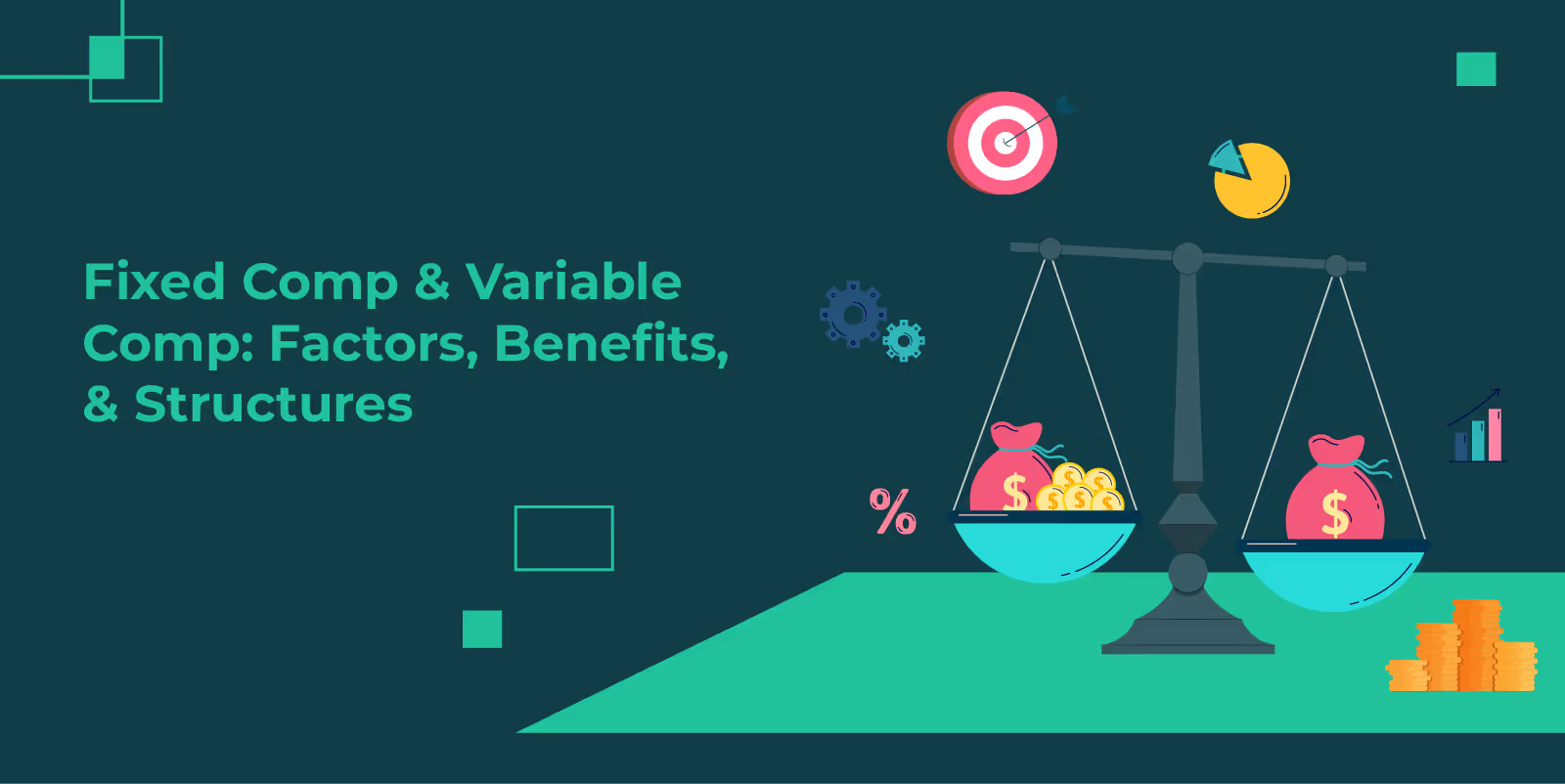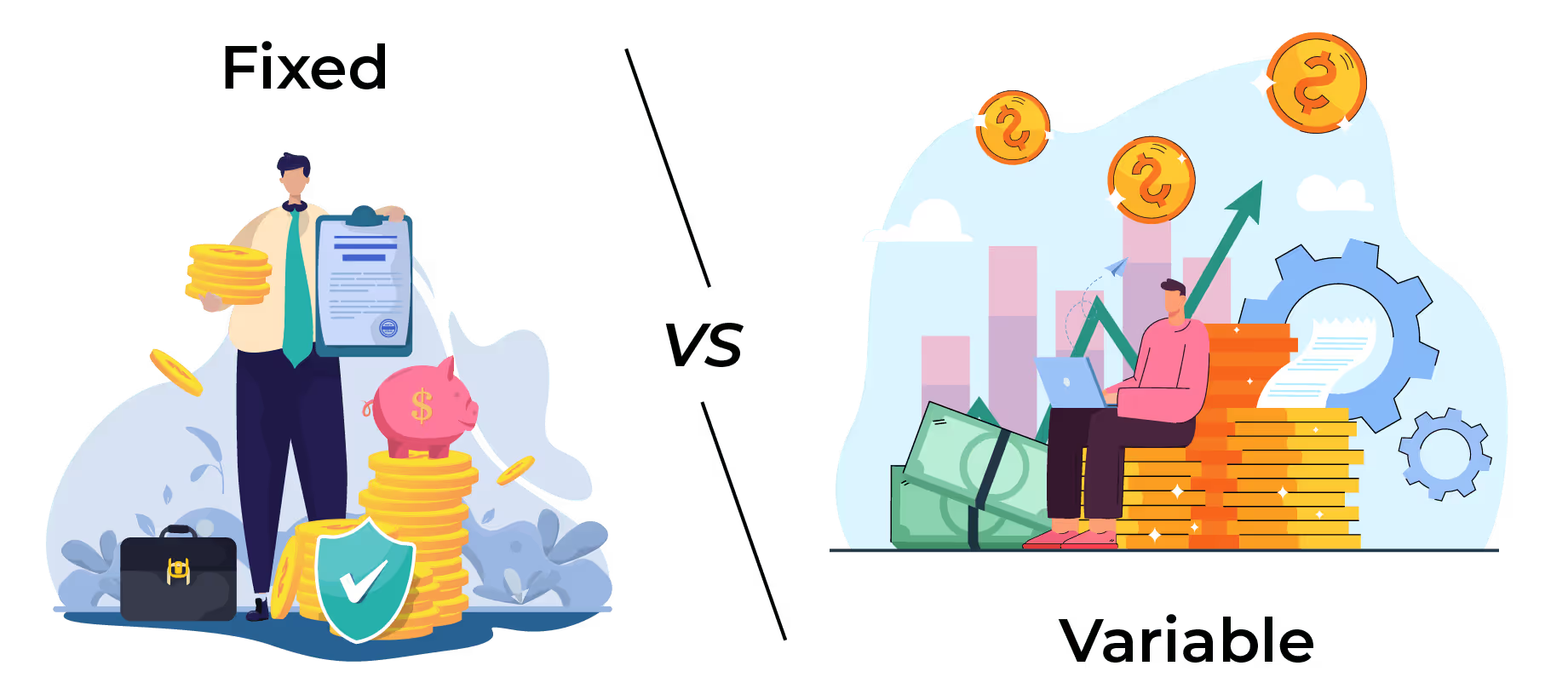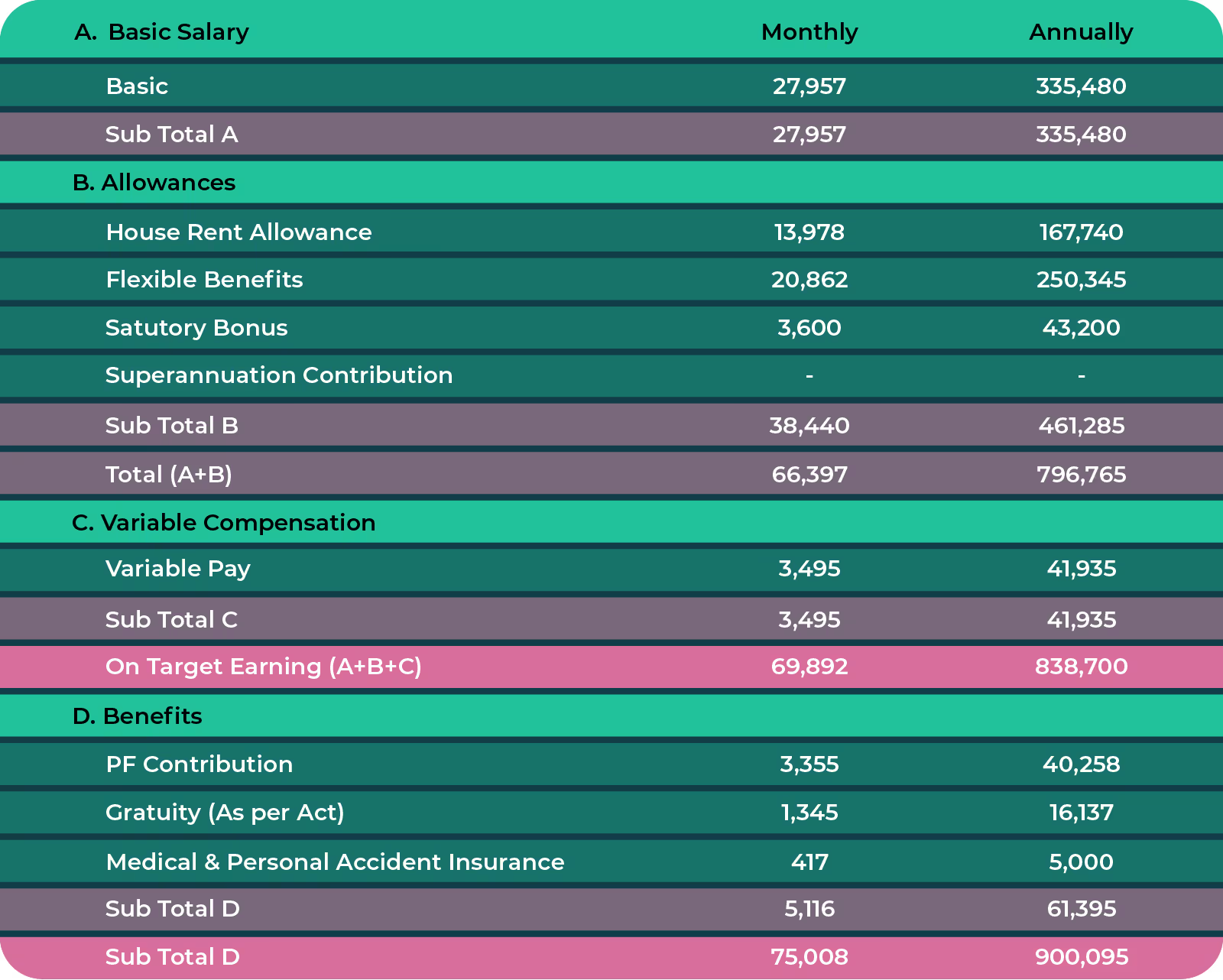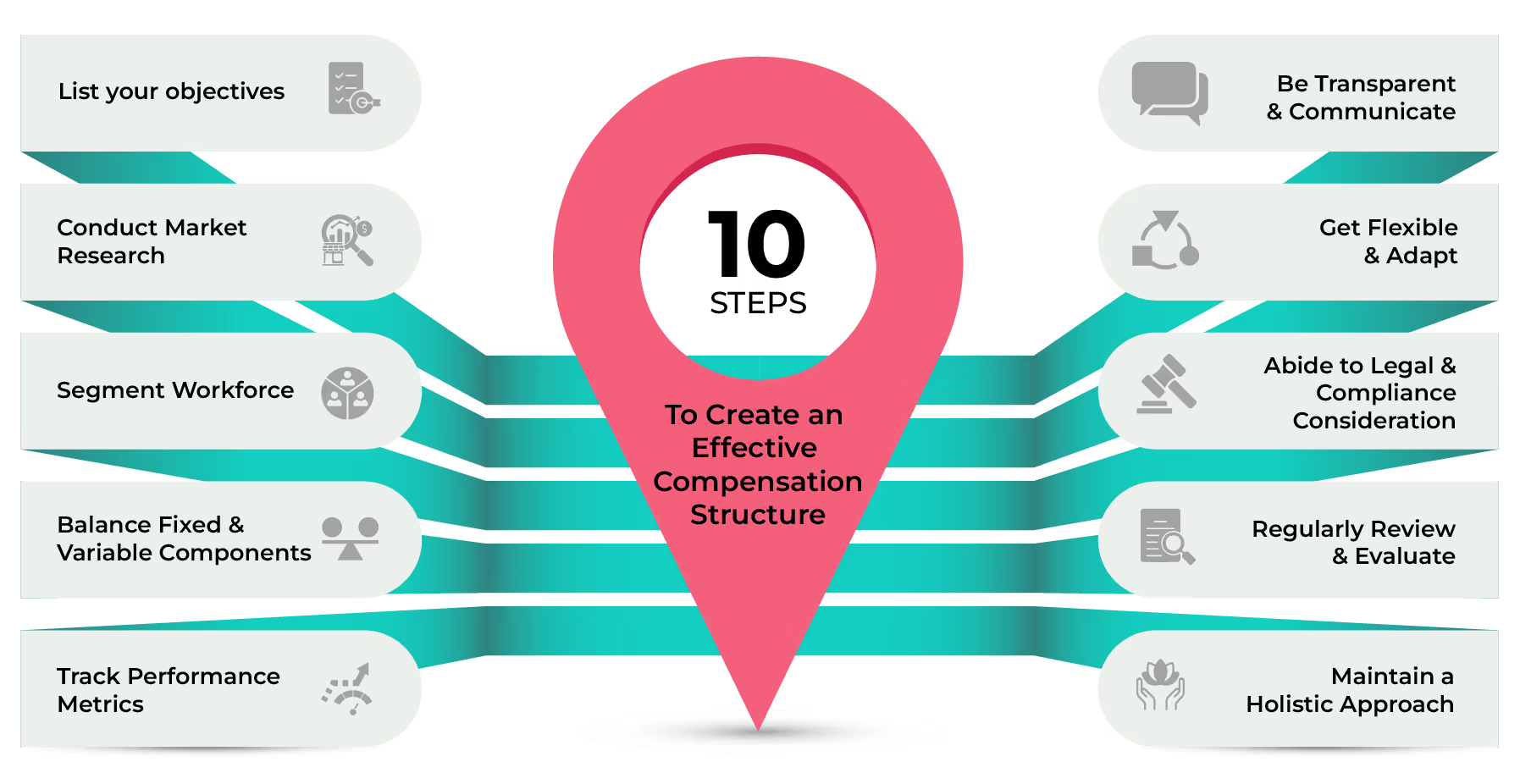
Blog
Fixed Comp & Variable Comp: Factors, Benefits, & Structures
June 20, 2024


Key Insights
Hey there, employers!
Remember when you were all in to get that perfect compensation structure sorted for your new hires? You know, the one that just makes everyone's eyes light up with excitement? Yeah, that's the dream.
But hey, reality check, it can feel like you're juggling a dozen balls at once, right? Understanding how to structure employee pay can get tricky at times, especially when terms like 'fixed comp' and 'variable comp' start flying around.
First up, let's understand both of them
👉🏼Fixed Compensation: The Foundation of Your Pay Structure
- What It Is: Think of fixed compensation as the reliable part of an employee's paycheck. It’s the steady amount that hits their bank account regularly, like clockwork.
- Why It Matters: This guaranteed salary is what your employees depend on to cover their expenses. It’s the backbone of their financial security.
👉🏼Variable Compensation: Motivating Performance
- What It Is: Variable compensation includes bonuses, commissions, and other incentives. It’s like a reward for hitting targets or going above and beyond.
- Why It Matters: It’s a great way to motivate your team to achieve more and align their efforts with company goals.
This blog is dedicated to helping all of you folks understand the depths of fixed comp and variable comp. By the end of this read, you'll have some solid insights on creating a fair, balanced pay structure.
Let's jump right in!
Fixed vs. Variable Compensation: A Quick Comparison

Understanding the differences between fixed and variable compensation is key to designing an effective pay structure for your employees. Here’s a quick comparison to get you started:
You need that sweet spot where employees feel secure but also motivated to perform well. A good mix of fixed and variable comp keeps everyone happy and engaged.
Detailed Structure of Compensation
Imagine compensation is like a delicious pizza. The base salary is the crust – it's the foundation, what keeps everything together. But a pizza wouldn't be very exciting without toppings, right? That's where bonuses, benefits, and other perks come in. They're the cheese, the pepperoni, the veggies – all the good stuff that makes the pizza truly enjoyable.
We'll dissect each topping, one by one, so you understand the whole delicious package!
Fixed Compensation Structure
Within a fixed compensation structure, an employee's total pay is predetermined and remains consistent.
Here's a breakdown of the typical elements found within a fixed compensation structure:
Salary:
This is the fixed amount of money paid annually. For example, if someone earns a $50,000 annual salary, they receive a consistent paycheck throughout the year.
Benefits:
These are additional perks beyond the salary, like health insurance, retirement plans, and vacation days. For instance, an employee might get medical coverage, a 401(k) plan, and three weeks of paid vacation each year.
Variable Compensation
Bonuses:
Bonuses are extra payments based on performance or company profits. For example, if an employee helps the company exceed its sales targets, they might receive a $5,000 year-end bonus.
Commission:
Common in sales roles, commission is extra pay based on sales made. For instance, a car salesperson might earn a 5% commission on each car sold, so selling a $20,000 car would earn them an extra $1,000.
Profit-sharing:
Employees receive a portion of the company’s profits. For example, if a company performs well, it might distribute 10% of its profits among employees, giving each employee a share based on their role and tenure.
To paint a clearer picture, let me show you and example of how fixed and variable compensation can blend together in a pay structure.

Now that we've covered fixed and variable compensation and how they work together, let's talk about what influences the base salary, a big part of fixed compensation. This will help you decide how to set the right base salary for your new hire!
Factors Influencing Compensation Ratio:
Several factors influence the ratio between fixed and variable compensation. Understanding these factors is crucial for designing a compensation structure that attracts, retains, and motivates employees.
- Industry standards and market trends: Each industry has its own compensation benchmarks. Jobs in technology and healthcare often offer higher salaries due to the specialized skills required. The state of the economy also plays a role; in a booming economy, companies may offer higher wages and benefits.
- Job role, responsibilities, and seniority: Compensation is heavily influenced by the nature of the job and its responsibilities. Specialized roles that require advanced skills or carry higher risks often command higher salaries. Senior roles typically earn more than entry-level positions due to increased responsibilities and decision-making power.
- Company financial health and growth stage: Larger, financially stable companies can often afford to offer more competitive salaries and benefits. Smaller businesses or startups might have more limited budgets. The company's compensation philosophy also plays a role; some prioritize competitive pay to attract top talent, while others focus on a balanced approach.
- Employee expectations and risk appetite: Some employees prefer the stability of a higher fixed salary, while others are motivated by the potential for higher earnings through variable pay. Companies may offer stock options or higher bonuses to encourage risk-taking and innovation.
What is performance-linked pay?
Performance-linked pay, also known as pay-for-performance, is a compensation structure where a portion of an employee's earnings is tied to their individual, team, or organizational performance.
This system rewards employees for meeting or exceeding specific, measurable goals. It's often used in roles with clear performance indicators, like sales, where goals might include revenue targets or units sold.
Performance-linked pay can take various forms, including bonuses, commissions, and merit-based pay increases.
How is performance-linked pay structured?
Performance-linked pay can be structured in several ways:
- Bonuses: Employees receive a one-time payment for achieving specific goals. This can be a percentage of their salary or a fixed amount.
- Commissions: Employees earn a percentage of sales or revenue generated. This is common in sales roles.
- Merit-based pay: An employee's base salary is adjusted over time to reflect sustained high performance.
- Gainsharing: Teams receive bonuses tied to improvements in performance, productivity, or cost savings.
- Incentive-based pay: Rewards employees for reaching specific targets. This can include financial incentives, like commissions, as well as non-monetary perks, such as additional paid time off (PTO), travel rewards, gift cards, or company stocks
What Factors Influence Base Salary?
HR Policies
HR policies are like your company's playbook, covering everything from hiring to performance reviews. They ensure everyone's on the same page. When it comes to base salaries, these policies set the standards for promotions and evaluations, keeping things fair for everyone.
Company Policies
Company policies shape your company's culture and values. They also influence base salaries by guiding how you structure compensation, reflecting what your company stands for and its priorities.
Designation
Designation directly impacts base salaries because different roles have varying levels of responsibility and skill requirements. Clearly defined salary ranges help attract and retain the right talent for each role.

Location or Country
Where a person is based matters for base salaries. Factors like cost of living and market demand vary across locations, so it's important to understand these differences to offer competitive pay that reflects local conditions.
Industry or Sector
Every industry has its salary norms. If you're in a sector with high demand for certain skills or where profits are booming, you might need to adjust your base salaries to stay competitive and attract top talent.
Advantages and Disadvantages of Fixed and Variable Compensation
Neither fixed comp nor variable comp are perfect. They both have their own upsides and downsides.
Let's break down the good, the bad, and everything in between to help you understand the ins and outs of compensation!
Fixed Compensation Advantages:
👍Stability and predictability:
Employees know exactly what to expect in their paychecks each month, which can be a major benefit for budgeting and financial planning.
👍Reduced stress:
Consistent income leads to less financial stress for employees.
👍Focus on core duties:
Employees are less likely to prioritize short-term gains over their core responsibilities.
👍Simpler administration:
Fixed salaries are easier for companies to calculate and manage.
Fixed Compensation Disadvantages:
👎Lower motivation:
Fixed salaries may not incentivize employees to go above and beyond their basic duties.
👎Less flexibility for companies:
Companies may have less control over payroll costs during slow periods.
👎Limited earning potential:
Employees have a fixed ceiling on their income, regardless of performance.
Fixed salaries are a double-edged sword. The good news? They're predictable, but the catch is it might not keep everyone constantly pumped.
It can be tough to keep that fire for exceeding goals burning bright without some extra fuel (Variable comp).
Variable Compensation Advantages:
👍Performance-based:
Variable pay can motivate employees to achieve better results and contribute more to the company's success.
👍Alignment of goals:
Ties employee compensation directly to company goals, fostering a results-oriented culture.
👍Higher earning potential:
Employees can significantly increase their income with strong performance.
👍Cost control for companies:
Companies only pay out bonuses or commissions when performance targets are met.
Variable Compensation Disadvantages:
👎Income uncertainty:
Variable pay can lead to unpredictable income streams, making budgeting difficult.
👎Increased stress:
Employees may feel pressure to constantly perform at a high level.
👎Unhealthy competition:
Variable pay structures can create competition among colleagues, hindering teamwork.
👎Administrative complexity:
Calculating and managing variable pay can be more time-consuming for companies.
Alright, alright, variable pay isn't perfect either. It can turn into a pressure cooker, making everyone frantically chase their goals just to get the bonus.
It's like everyone's got their eye on the prize, but nobody's having fun on the ride.
As an employer, you still need to make sure the work itself is engaging, and there are growth opportunities.
10 Steps to create an Effective Compensation Structure
Only 32% of workers feel like they’re paid fairly, according to a new Gartner survey. Yikes! This shows why it's so important to get compensation right so your team doesn’t end up feeling the same way.
Now, I get it deciding on a pay structure can be overwhelming with so many factors to consider. It's easy to lose track and get confused. There's a ton to think about, from salaries and benefits to keeping things fair and competitive.
To help you out, here’s a straightforward 10-step strategy to create an ideal compensation structure for your organization!

☑️List your objectives:
Start by clarifying your goals. Are you aiming to attract top talent, retain your current workforce, or incentivize specific behaviors? Understanding your objectives will guide the rest of your compensation strategy.
☑️Conduct a Market Research:
Conduct thorough research to understand the prevailing compensation trends in your industry and region. This includes benchmarking salaries, benefits, and incentives offered by competitors and similar organizations.
☑️Segment Workforce:
Recognize that different roles within your organization may require different compensation approaches. Segment your workforce based on factors like job function, experience level, and performance.
☑️Balance Fixed and Variable Components:
Strike a balance between fixed and variable compensation. Fixed components provide stability and security, while variable components offer incentives for performance and achievement.
☑️Track Performance Metrics:
Clearly define the metrics and KPIs that will drive variable compensation. These should be tied to individual, team, and organizational goals, ensuring alignment with broader objectives.
☑️Be Transparent and Communicate:
Be transparent about your compensation structure and how it aligns with organizational goals. Communicate clearly with employees about how their pay is determined and the opportunities for advancement.
☑️Get Flexible and Adapt:
Recognize that compensation needs may evolve. Build flexibility into your structure to accommodate changes in market conditions, business priorities, and employee preferences.
☑️Abide to Legal and Compliance Considerations:
Ensure that your compensation structure complies with relevant laws and regulations, including minimum wage requirements, overtime rules, and anti-discrimination laws.
☑️Regularly Review and Evaluate:
Continuously monitor and evaluate the effectiveness of your compensation structure. Solicit feedback from employees and make adjustments as needed to ensure it remains competitive and aligned with your objectives.
☑️Maintain a Holistic Approach:
Take a holistic view of compensation, considering not just salary but also benefits, perks, and opportunities for development and advancement. A comprehensive approach will help attract, retain, and motivate top talent.
Stick to these steps when creating a pay structure, and voila! You'll have a successful plan that makes your employees more satisfied than ever!
What is performance-linked pay?
Basically, linking pay to performance is performance-linked pay.
This means high performers get rewarded with salary increases. It's about how one rocks those pre-agreed objectives.
Now, the real tea: what makes these performance-linked pay strategies super successful? Let’s crack the code.
How is performance-linked pay structured?
Now, to make this whole setup work smoothly, there's gotta be a solid structure in place. That means you need clear criteria for what "good performance" actually looks like. You can't just say, "Do well, and we'll give you more money." You need specific goals or metrics to aim for.
You need a fair way to appraise performance. To make it all work, you need to have clear targets, fair assessments, and ongoing support for everyone involved.
1️⃣Setting Clear Expectations:
It starts with setting clear goals and expectations. It's like telling someone, "Here's what we need you to achieve."
2️⃣Measuring Performance:
Then, you need a way to measure how well someone is doing. Imagine it like keeping score in a game, so you know who's winning.
3️⃣Giving Feedback:
Regular feedback is key. It's like having a coach who tells you what you're doing well and where you can improve.
4️⃣Fair Evaluation:
The evaluation process should be fair. You wouldn't want someone to judge you unfairly, right?
5️⃣Aligning Incentives:
The rewards should match the goals. It's like getting a prize for doing something great.
6️⃣Encouraging Growth:
There should be room to grow and improve. It's about getting better over time.
7️⃣Transparent Communication:
Everyone should know how it all works. It's like having an open book, so there are no surprises.
8️⃣Supporting Success:
Success is not just about the individual; it's also about how the team supports each other.
9️⃣Evaluating and Improving:
It's not a set-it-and-forget-it thing. You should always look at how things are going and make changes if needed.
1️⃣0️⃣Celebrating Achievements:
And lastly, celebrate achievements! It's important to recognize when someone does a great job.
Food for thought
Alright, that's the deal. The magic formula isn't just a paycheck, it's the combo of fixed comp and variable comp that keeps your crew happy and motivated.
Now, onto your pain point!
Managing these compensation structures can be exhausting, especially when you're dealing with mountains of data. It's like walking a tightrope every month, with tons of calculations that can easily get messed up when done manually.
That's where Kennect steps in to make your life easier. With Kennect, everything becomes effortless. It automates, engages, and analyzes, all in one go.
Why struggle in-house when you can simplify with Kennect? Curious? Get Ready to see it in action! Book a demo!
ReKennect : Stay ahead of the curve!
Subscribe to our bi-weekly newsletter packed with latest trends and insights on incentives.
Thank you! Your submission has been received!
Oops! Something went wrong while submitting the form.
Your data is in safe hands. Check out our Privacy policy for more info















